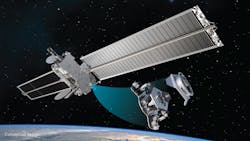Lockheed Martin submits industry standard for docking satellites to facilitate several different vendors
LITTLETON, Colo. – Spacecraft designers at Lockheed Martin Corp. are promoting industry standard approaches for docking orbiting satellites that are built by different integrators and subsystems manufacturers.
Officials of the Lockheed Martin Space segment in Littleton, Colo., have released the Mission Augmentation Port (MAP) open-source non-proprietary interface industry standard to support on-orbit docking within the industry.
The MAP standard provides a mechanical interface design for docking spacecraft to one another. Equipping satellites with docking adapters is one way to add new mission capabilities to a satellite after launch, company officials say.
Lockheed Martin’s Augmentation System Port Interface (ASPIN) is designed to comply with the MAP standard. The ASPIN adapter provides an electrical and data interface between satellites.
The MAP standard can help designers to develop their own MAP-compliant docking adapters to enable interoperability of docking satellites. The standard describes a physical mate of docking port halves, such as the dimensions of plates and petals, with suggestions for electrical interfaces and docking profiles.
“Just like USB was designed to standardize computer connections, these documents are designed to standardize how spacecraft connect to each other on orbit,” says Paul Pelley, senior director of advanced programs at Lockheed Martin Space.
Standardized docking interfaces can enable satellite operators to carry out a new type of mission upgrades, Lockheed Martin officials say. The standard can help satellite operators reconfigure hardware capabilities to meet evolving mission needs.
Related: The MP42 microsat will carry payloads from OQ Technology, Veoware into low Earth orbit
Such upgrades could include processors, data storage, or sensors that add longevity and value to satellite missions. The standard also could facilitate rapid prototyping and testing of new satellite mission capabilities. Some satellite components also could be replaced or upgraded after launch with new hardware.
Future missions could receive technology insertion and upgrades via on-orbit hardware and software upgrades, Lockheed Martin officials say. “Ultimately, our goal is to drive the development of a new ecosystem where a platform’s function can change at the pace of technology,” Pelley says.
Those interested can download the new MAP standard online at https://contact.lockheedmartin.com/map. For more information contact Lockheed Martin Space at https://www.lockheedmartin.com/en-us/capabilities/space.html.
